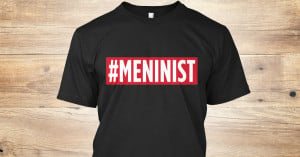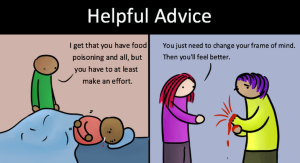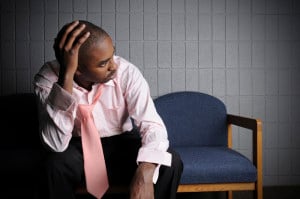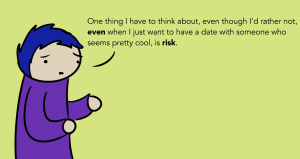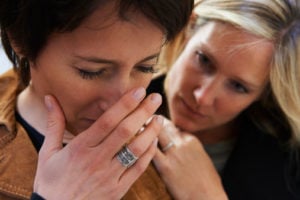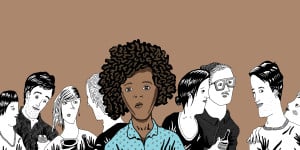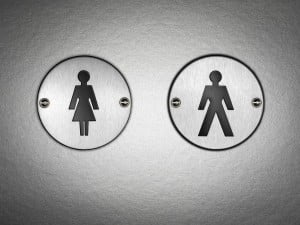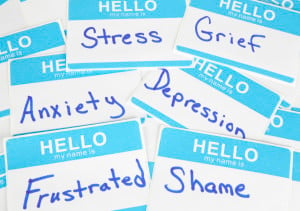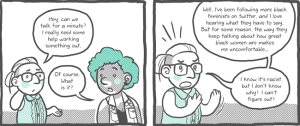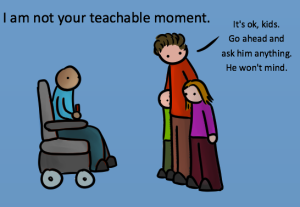
A person sits sadly at a picnic table in the forest, propping their head up with their hands.
Originally published on Medium and republished here with the author’s permission.
Nervously sitting in the WorkSource office in downtown Seattle, a slip of paper with my number rapidly yellowing with sweat clenched between my fingers, a man in filthy jeans and mismatched shoes turned to me and asked what I was doing there.
“You don’t look poor enough to be here,” he told me.
He was right. I didn’t.
Because what we collectively think of as “looking poor” does not, in fact, encompass the real face of poverty in this country. As a white, 22-year-old college graduate in a second-hand dress, I did not look like what we think of as “poor.”
Of course, at that exact moment, I had, yes, a college degree and a coveted unpaid (because of course it was unpaid) internship at a public radio station.
But I also had a minimum wage job to support myself, $17 in my bank account, $65,000 in debt to my name, and $800 in rent due in 24 days. I was extremely hungry, worried about my utilities being shut off, and 100% planning to hit up the dumpster at the nearby Starbucks when I was done there. I had no functional stove in my tiny apartment because the gas it took to make it work was, at $10 per month, too expensive. I was at WorkSource to find out if I qualified for literally any program to make my finances less crushing.
I had, like millions of other working Americans and many, many Millennials, no financial safety net.
In the United States, approximately 15% of residents live below the poverty line and another 10.4 million are considered “the working poor.” And yet, we have very, very concrete – and very incorrect – perceptions about how poverty actually looks. And it does not look like Millennial college grads. So we kind of keep ignoring it.
The disconnect is simple: Poverty doesn’t look the way we think it looks, so we don’t think people who are, in fact, poor look poor, so we assume that poverty isn’t really that bad. We also assume that by taking steps that have traditionally been associated with improved economy status, it will get better.
We are now seeing that it might not.
Through college debt, we are minting a new generation of people with fewer opportunities, rather than more.
Even if you glossed right over the teachings of Thomas Piketty, you probably know that those who begin poor are more likely to stay poor. And boy howdy, is that true. When you are constantly fighting your way up from zero (or negative), you tend to stay that way. And when education is supposed to be the path out, if it leads to more debt, it’s more cyclical than linear. New grads no longer start from zero – they start with a negative balance.
Consider what we’re setting up for our future by thinking about poverty in terms of how it should be, not how it is: We are pushing education on everyone, then punishing education and the pursuit of a higher income with so much debt that there is no way to win.
There is an assumption about college students that, when they graduate, they will be permitted a small amount of time to get back on their feet by moving home with their parents. With no small amount of contempt, we refer to these people as “boomerang kids.”
But, just as is the case with almost everything, ever, the ability to move back home – to take an unpaid internship without batting an eye – is, in and of itself, a huge privilege. And it is a privilege that begets other privileges.
In 2012, nearly half of American households were just one emergency away from poverty or homelessness. Most Americans don’t have the savings for literally one – ONE – unexpected bill. There are more individuals considered “the working poor” than not. Over 1.5 million individuals were estimated to have been homeless at some point in 2014.
In a country where people never agree on a damn thing, nearly 75% of people can agree on the sentiment that the poor are getting poorer.
They aren’t just getting poorer, though. We are making them poorer.
In the US, about a third of college students are first-generation attendees, meaning their parents did not go to college. That percentage is much higher among people of color. Many of them – and even many students whose parents did go to college, but it’s worse for first-gen students – don’t have the ability to move home after college, either because:
A. Their parents don’t have the means to support them.
B. Their parents live in impoverished areas where, if they were to move home, they would be unable to find work.
C. Some combination of A and B.
Or, possibly:
D. Maybe they are one of the 20,000 kids who age out of foster care each year, and there is just nowhere else for them to go.
But for many of those first-gen college students (and students whose parents, too, are considered the “working poor,” but might even have some college) graduation puts them worse off than they were before. The idea that there is a safety net – that boomeranging is the norm – is just not true, and it is detrimental.
Saddled with student loans they statistically will not be able to pay off for at least a decade (the average debt is about $30,000; the average income for a recent new grad is only about $44,000, and the unemployment rate hovers around 8.5%), which are due every month on top of rent and other expenses, many college graduates are worse off than they would have been if they’d directly entered the workforce debt-free. More college students live in poverty – actual poverty, not just “can’t-afford-pizza-better-call-the-parents” brokeness – than the overall population. One in five Millennials is considered “in poverty” today, up from one in eight in 1980.
The cycle is predatory. From the Boston Globe, reporting on a study released by Crittenton Women’s Union:
The study, based on a survey of more than 100 low-income individuals, found that most of the debts resulted from stretches of unemployment, medical costs, and student loans. The study also found that poor people are often overwhelmed by high interest rates that make it nearly impossible to pay down debts, then penalized again when prospective employers or landlords conduct credit checks before hiring or renting to them.
And the prospects are not improving. Because as income increases for college grads (58% of Millennials will receive a bachelor’s degree), so does the cost of living. So do interest rates. So does the rent. So do home prices. So does the cost of doing literally everything.
“Good” jobs – those jobs you need a degree for – still don’t pay the bills. More new college grads use food stamps than ever before; in fact, the demand has doubled. And while Millennials are arguably facing the brunt of it, it doesn’t end there; even seniors are being hit by lingering student debt.
Seniors. Who are on Social Security. Which means everyone is feeling it.
So what do we do? Make college more affordable? Free, even? Nope, say some. That won’t work, either.
In January 2015, President Obama floated the idea of offering two free years of community college to everyone; critics immediately raised their fingers to point out that if that happens, some people of means might take advantage of that offer. Or that maybe a college education isn’t even worth that much, anyway, so why go into deeper national debt to provide one to everyone?
Almost no solution for this problem seems to please anyone – and almost all of them that do have some kind of bipartisan support rely on already having access to money and resources or settling for an education that could put you at a disadvantage (something I’ve written about before).
You have to spend money to even have the hope to make money. And maybe not even then.
And yet, when most people think about poverty, they think something else. Maybe they think about a homeless man begging for change. Maybe they think of the “welfare queen” – ugh, what a horrifically racist trope – who bilks the government for money (when, of course, it is actually the wealthiest who take the most). Maybe they think about a family that looked a lot like mine did growing up – one provider, too many kids, receiving WIC and food stamps and every other kind of assistance we could, and even then, still living precariously close to poverty.
Most likely, they imagine brown faces. Because, don’t forget, part of what a lot of people mean what they talk about what poverty looks like is a statement on race in America. When the man at WorkSource told me I didn’t “look poor enough,” my whiteness was probably a big part of that sentiment.
And that is also inaccurate. Which is not to say that people of color (and especially Millennials of color) don’t experience disproportionate unemployment – they do – but it is to say that poverty is an everybody issue.
“As it turns out, our deeply racialized view of poverty bears no resemblance to reality,” writes Leonard Pitts, Jr. for the Miami Herald. “Though it’s true that African Americans are disproportionately likely to live below the poverty line, it is also true that the vast majority of those in poverty are white: 29.8 million people. In fact, there are more white poor than all other poor combined.”
Still, the ongoing challenges that face Millennials of color are real; they face more and different struggles than white Millennials when it comes to even getting into college. Higher high school dropout rates, disproportionate rates of incarceration, and other factors all contribute to the difficulty of even making it to college. The paths to college for white and non-white Millennials are very different. But to what end?
Often, college graduation rates among people of color are hailed as proof that things are getting better (which, in some cases, is actually pretty hopeful), because, while Millennials are seeing some closure in the race gap, graduation rates are still pretty unequal.
Except that graduation is still not a guarantee of wealth or success or even improved economy status. Oh, and don’t forget about that gender pay gap, which starts basically right after women – yes, even women in STEM – get their diplomas.
Whatever poverty looks like to the general population, it is clearly not very sympathetic; most people don’t think that the government should provide more assistance than they currently are. In a 2012 poll, the majority of Americans surveyed said they thought welfare is being abused by those who rely on it. And our lawmakers continue to make it harder to bail ourselves out, blocking bills that would help make education less bank-breaking.
But we also, collectively, tend to agree that poor people do not face an even playing field, and that the roots of poverty are systemic, not a result of laziness or failings by those who are poor. We support raising the minimum wage because the plain fact is that shit is more expensive now than it was 10, 30, or 50 years ago, and the idea that everyone should be able to rise out of poverty is just not realistic.
I have been poor more than I have been not-poor. I grew up poor. I went to a university – something that neither of my parents did, through choice and circumstance and a systemic series of beliefs about who college is for – because I believed that that was the only way to be not-poor. I believed this because I was told it, by guidance counselors, the media, and many adults.
And yet, going to college made me more poor, at least in the years since I’ve graduated. More financially strained than I ever could have imagined. More crushed by the persistent weight of debt. More driven by income than almost anything else. This is not about a lack of fiscal responsibility; this is the fallout of a culture that says there is only one way to get ahead, and that way is a treacherous one.
When we talk about Millennials, we can’t not talk about the debt that keeps us reined in, and the difficulty in getting out of it.
We – I – don’t look poor. And most often, I find it too uncomfortable to talk about how really easy it is to be poor, even when you’re working and you went to college and you are doing everything “right.”
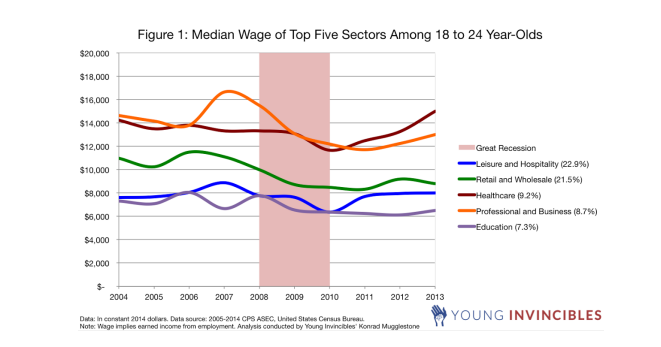
“Median wages have declined or remained unchanged in the last decade in four out of the top five industry sectors employing 18 to 24 year-olds.”
– Survey, The Young Invincibles
So I have to wonder: What if we stopped trying to decide who was poor based on appearance and actually looked at the financials of those who were scraping by? What if we calculated poverty not based on those who were literally already homeless (though, to be honest, we do a shit job of that, too), but rather based on everyone who is one missed shift away from being completely out of money and options?
What if people with resources – people who went to college at a time when they could pay for college without accruing mountains of debt, or people whose parents were fortunate enough to be able to save for them on their behalf – stopped chiding those without for their perceived poor decisions, and instead, decided to actually address the problem (which is that it is damn near impossible to get out of poverty in this economic climate)?
What if we acknowledged that there are more poor people than we realize, and that even doing literally everything prescribed by those with wealth does not guarantee wealth?
What if we stopped wringing our hands about the death of the middle class and did something to attempt to resuscitate it?
To this day, I don’t “look” poor. I have a nice apartment, the right kind of job, clothes that don’t look like I bought them all on clearance years ago. But don’t let my appearance fool you – I’m that Millennial who’s ruining the economy with my choices.
I don’t own a vehicle. I likely won’t be anywhere near able to afford homeownership until I’m well into my thirties (no matter how many people tell me it’s “actually not that hard” to get together a down payment) – in no small part because I started my path to adulthood, as I was told to do, at a five-figure deficit.
And frequently, at the end of a pay period, after paying rent and another $600 in student loans for the privilege of becoming the first in my family to graduate from college, I’m right back to being one unforeseen expense away from an overdraw.
I don’t look poor – most of us don’t – but that doesn’t mean a whole lot.
[do_widget id=’text-101′]
Hanna Brooks Olsen is a writer, small human, and a Millennial. Her interests are politics, podcasts, Pac-12 football, feminism, and Oxford commas. She is curious to a fault. Follow her on Twitter @mshannabrooks.
Search our 3000+ articles!
Read our articles about:
Our online racial justice training
Used by hundreds of universities, non-profits, and businesses.
Click to learn more






